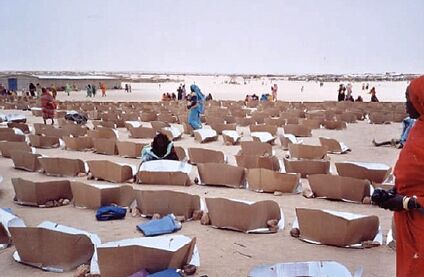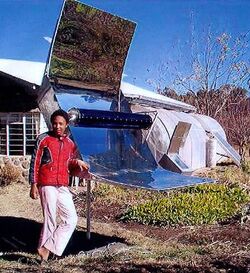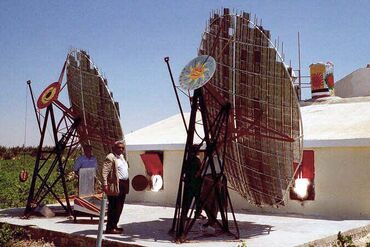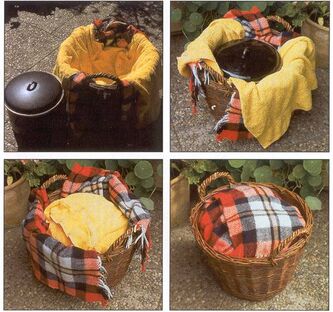Solar cooking is being used to cook for large numbers of people. Below is a description of how this is being done around the world:
Build a number of smaller cookers
This is an effective strategy for refugee situations. the Iridimi Refugee Camp in Chad, thousands of CooKit solar panel cookers are being used to cook for over 17,000 people each day. These cookers are built by the refugees themselves. This method is also used by the Villaseca Solar Restaurant in Chile.
 At the Iridimi Refugee Camp in Chad a small workshop run by the refugees themselves has built cookers for 17,000 camp residents. |
 The Villaseca Solar Restaurant in Chile uses a dozen or so box cookers and a few parabolic cookers to prepare food for their patrons. |
Build a very large box cooker
Sun Ovens International makes a giant solar box cooker with propane back-up, which it markets as a village bakery. I think several hundred of these have been installed in various parts of the world. Some members of Rotary International have formed a project that seems to specialize in buying these cookers to donate to selected villages. The company is called Sun Ovens International, and the giant box cooker is called the "Villager" or Villager Sun Oven. They are large capacity solar cookers. The cost is somewhere around 11 thousand USD.
Others have build very large box cookers that can be used to cook large amounts of food or bake dozens of loaves of bread at one time.
 The Villager Sun Oven can bake dozens of loaves of bread at one time |
 Large box cookers such as this can cook large amounts of food. |
 Rolf Behringer has used large box cookers to set up small-scale solar bakeries. |  Parabolic trough cooker bakes 10 loaves of bread at one time. |
See also
Build a Scheffler Community Kitchen

Scheffler Community Kitchens can cook for hundreds or even thousands of people per day.
There are specialists who design and install institutionalized solar cooking systems that cook for large groups. Several years ago, a system was installed near Mt. Abu in India that reportedly cooks for 30,000 people. The concept is called the Scheffler community kitchen, named after its creator, Dr. Wolfgang Scheffler. As with Mt. Abu, they can be made for extremely large kitchens or for smaller ones. I really don't know how small they can go before their cost-effectiveness deteriorates.
The basics of the system are as follows: One or more very large parabolic reflectors are built next to the kitchen, outside in the bright sun. These reflectors are equipped with motors that cause the reflectors to track the sun and focus the reflected light through a hole in the wall of the kitchen. The powerful beam of focused light is directed onto a reservoir that holds a liquid such as water or vegetable oil, making it very hot. Pipes distribute the heated fluid (in some cases as steam for steaming rice and vegetables) to various cooking stations in the kitchen, where the heat is used to cook food. If several of these large reflectors are used, it seems likely to me that you would need several holes in the wall and several places where the beams of light could heat up the reservoir containing the fluid. These systems are not cheap, and people have to be trained to maintain the reflectors and the equipment for tracking the path of the sun.
Experts in the field are Wolfgang Scheffler (Germany), Dr. Deepak Gadhia and Jimmy McGilligan (India), and Heike Hoedt, who is building Scheffler reflectors to boil down maguey syrup in Mexico.
See main article: Scheffler Community Kitchen
Combine heat-retention cooking with solar cooking
Heat-retention cooking increases the amount of food that can be cooked in one day in a solar cooker because after food has been heated to cooking temperature, it is placed into an insulated box where it will continue to cook until it is done. Retained-heat cooking is often introduced along with solar cooking since it further reduces the use of traditional fuels such as firewood, and the use of this method allows much more food to be cooked each day in a solar cooker. This method of cooking is also known as retained-heat cooking, fireless cooking, haybox cooking, or wonder box cooking.
Heat-retention cooking is an age-old method that can be used to conserve energy not only during times of crisis, but anytime. Depending on the food item and amount cooked, the use of a haybox or insulated cooker saves between 20% and 80% of the energy normally needed to cook a food. The longer an item usually takes on a stovetop, the more fuel is saved. For example, with a haybox, five pots of long-cooking dry beans will use the same amount of fuel to cook to completion as just one pot cooked without a haybox.
See main article: Heat-retention cooking
Use a pre-heater

A simple reflector made from one corner of a cardboard box can be used to preheat food or water before cooking.
It is also possible to preheat one pot of food as another is cooking in the solar cooker. The illustration shows a simple preheater that can be made from one corner of a cardboard box.

